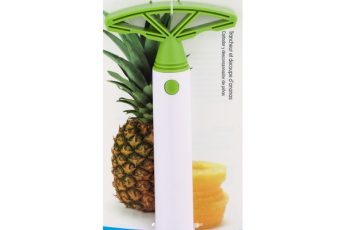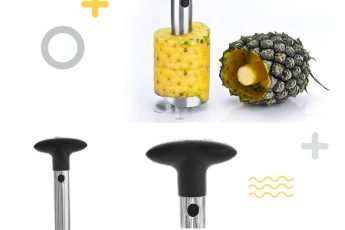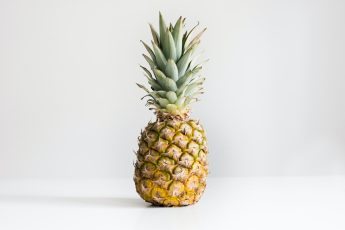How to Prepare a Pineapple Using a Pineapple Corer
If you want to use a pineapple corer, here are some useful tips and tricks. Here, you’ll learn how to prepare a pineapple, slice it, and know more about the toxic substances found in pineapple. Moreover, you can also get an overview of pineapple anatomy and physiology, so you can decide whether you want to try using a pineapple corer or not. Hopefully, these tips will save you some time and effort!

Preparation for using a pineapple corer
Using a pineapple corer can make the process of processing a pineapple a lot easier, but the tool is not without its own set of preparations. First, you must cut the top and leaves off the pineapple in order to gain access to the core. Next, prepare a large bowl or cutting board. This will prevent any sticky residue from forming. Once the pineapple is prepared, the corer should easily penetrate the fruit.
You may want to cut the pineapple into quarters. This will help you remove the core easily. Alternatively, you can cut the pineapple in half lengthwise and slice it in the other direction. You can even cut it into smaller pieces. Once you have removed the core, you can slice the pineapple into chunks. In very ripe pineapples, you can even cut each quarter into bite-size pieces.
Taking the core out of a pineapple is easier than ever before, and you’ll be able to make delicious fruit in no time. Simply insert your corer into the pineapple, twist it clockwise, and stop when it hits the bottom. The core will be hollow, but the juice will be inside. Remove the core from the corer and pour the juice into a separate container to enjoy later.
Then, prepare the pineapple. Slice it into rings and wedges. You can use the same pineapple corer several times, depending on its size. A stainless steel corer should be sharp, as a dull blade will tear the fruit while you are working, leaving behind wasted fruit. A sharp blade will allow you to cut deep into the fruit without causing any damage. A dull blade will also result in uneven slices and more juice spills.
The pineapple core is a fibrous, hard-to-chew part. The core can be removed with an apple corer, and the leftover slices can be added to Hawaiian casserole or a tropical pineapple smoothie. You can keep the remaining pineapple slices in the fridge for a couple of days or freeze them. A pineapple corer will make the process much easier. This pineapple corer will save you a lot of money compared to buying cubed pineapple at the grocery store.
To begin using a pineapple corer, hold it on the bottom side. Next, remove the eyes, green bits, and brown parts from the fruit. Then, twist the tool’s handle up and down until the core is in the middle. Once the core is removed, turn the pineapple on its side and slice it into rings or cubes. If you need a pineapple corer, you can buy one here.
Techniques for slicing a pineapple
If you are not a professional chef, you may not have seen how to slice a pineapple using a pineapple corer. A pineapple corer cuts through the middle of a pineapple, removing the core without damaging the flesh. To slice a pineapple using a corer, stand the pineapple upright on a chopping board. Then, place the corer over the center of the pineapple and twist it. Remove the corer and slice the pineapple into spears.
Slice the pineapple in half, leaving the eye on the outside. Cut the flesh as thinly as possible, leaving only the eyes and core of the pineapple. Once the eye is removed, turn the pineapple over and repeat the process with the other half of the pineapple. You can use the eye on a pineapple as a garnish, but the rest of the pineapple is not as tasty as it is when it is cut with a corer.
Regardless of your preferred method, a pineapple corer will simplify the process. First, clean the pineapple. Make sure it is dry to prevent any potential slipping. The juice from a pineapple can make a cutting board slippery. It’s best to keep as little water on the board as possible, and wipe away any spindly bits with a dry kitchen towel.
Peel the pineapple by cutting across the top and bottom. Slice away the outer peel while not cutting too much of the flesh, as the outer edge is the sweetest. Remove any remaining eyes with a paring knife. After you have removed the core, discard the remaining pieces of the fruit. To avoid cutting too much skin, you can use a small paring knife to remove the remaining skin.
While pineapple cutting can be a challenging task, the benefits outweigh the pain and effort. A pineapple corer will make your task easier. And it’s a great way to enjoy pineapples anytime you want. Use it to enjoy the sweet and sour taste of pineapple! Once you learn how to slice a pineapple with a corer, it’ll be easier than ever before!
To avoid slicing a pineapple with a corer, you must first select a pineapple that is ripe. Pineapples are not over-ripe unless they have an amber or yellow tint. A green pineapple is unripe. However, you can also test it by smelling it. If it smells bad, it probably isn’t.
To find ripe pineapples, start by inspecting the fruit. Ripe pineapples are golden yellow in color and will give a little when squeezed. Their inner leaves will be crisp and fragrant. Remove the core and slice the pineapple into chunks, rounds, or spears. To determine whether a pineapple is ripe, smell the bottom end first. If the pineapple smells like pineapple juice, it’s likely too ripe.
Toxic substances in pineapple
In 2001, an official of the National Environmental Authority (ANA) warned about the high levels of agrochemicals used in the production of pineapple. He stressed the importance of protecting children’s health and water sources from these chemicals. In 2002, the ANA recommended that the use of pesticides in pineapple farming be curtailed. The agency also recommended evaluating pesticides used in the production of pineapple. As a result, the government is removing certain chemicals from the market and making a plan to clean up the affected areas.
Although the United States did not ratify the Rotterdam Convention until 2004, the use of certain highly toxic pesticides is still widespread in the country. The Pesticide Action Network, an advocacy group for the environment and public health, says the use of benzimidazole and mancozeb in pineapple is a significant source of poisonings in Costa Rica. Researchers linked these chemicals with reproductive health concerns. This suggests that there is still a widespread problem with the use of these chemicals in the pineapple industry.
The environmental effects of pineapple production are widespread. The pineapple industry has been accused of contaminating water sources, destroying protected areas around springs, and violating workers’ rights. Moreover, the intensive use of chemicals and agrochemicals has contaminated water and soil, resulting in widespread pollution. Some local communities have even lost access to safe water. These problems have led to the squeeze on the industry, which is ultimately affecting the workers most.
While the skin of a pineapple is not considered poisonous, the flesh and the leaves have toxic effects. A pineapple enzyme, called bromelain, is used as a meat tenderizer. Although it has low toxicity, it is believed to cause swelling and tenderness around the mouth. The pineapple thorns and leaves contain sap that can cause skin irritation. This can result in a rash. Some drugs interact with bromelain, so it is best to consult with a doctor before consuming pineapple.
A pineapple’s sugar/acid ratio and ascorbic acid content vary from cultivar to cultivar. In the final two weeks before full ripening, the sugar content increases from four to fifteen percent. Unripe pineapple is not edible and can cause a painful throat and act as a drastic purgative. Furthermore, pineapple core consumption can lead to fiber balls in the digestive tract. However, pineapple has other health benefits, such as increased production.
The pineapple industry in Costa Rica has a history of hostile attitudes towards independent unions. The fruit industry’s geographical location and political history have contributed to this hostile climate. Carlos Arguedas, the environmental and health officer of the Sitrap union in southern Costa Rica, has been jailed 23 times since 2004 for union activism. So, how can we protect our health and the environment from the toxic substances that are used? In this article, we explore the potential solutions.








